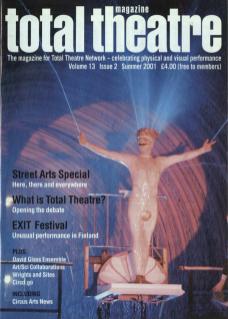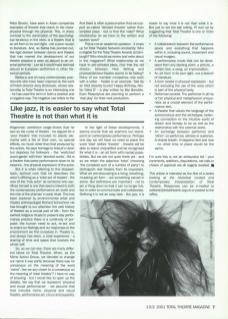Where to start? I became aware when researching for my MA that the term Total Theatre had been used many times by many different people to mean many different things. The earliest reference that I came across was in a document entitled 'Concerning Total Theatre – a Concerto for Man', written in the 1930s and referred to in Jean-Louis Barrault's book Reflections on the Theatre. In it, Barrault and his companion Antonin Artaud sketched out their hopes for a future theatre: 'Chords – harmonies – discords – dissensions, and so on. Gesture carried to the extreme limit of its capacity. As well as breath, cries, articulation, SPEECH, in fact. Perhaps one day a dramatic poet will be tempted by such a subject.'
Artaud needs no introduction, but I'd like to dwell a moment on Barrault, who occupies an interesting position in the story of what is now known as the Total Theatre Network. A former partner of Étienne Decroux, he was seen by Jean Dorcy, amongst others, as the hope for the future of mime – someone who would bring the artform in its pure essence to the public. But Barrault found it hard to occupy this role, preferring instead to experiment with the integration of corporeal mime with spoken text, strong visual imagery and song. It is interesting that even in its infancy as an artform, there was controversy about the use of the spoken word and other performance elements in corporeal mime. Then, as now, the argument about what does and doesn't qualify as mime was a hotly debated subject. Barrault's 1935 performance piece Auteur d'une Mère may have incited fear and loathing in both the traditional theatre and new mime camps – but it inspired Artaud to observe: ‘... new relationships between sound, gesture and voice ... what Jean-Louis Barrault has done IS theatre.’
Perhaps this work was the first example of contemporary Total Theatre – a theatre that Artaud describes as ‘that which furnishes the spectator with the truthful precipitates of dreams'. I have always been drawn to this quotation. For me, one of the defining characteristics of the theatre that we represent is that it leans more towards what Julia Kristeva calls the semiotic, poetic and physical language of the mother rather than the symbolic, logical and discursive language of the father. Put another way: a simple gesture, a slow walk across a stage, a tumbling clown, a puppet, a poem are all as real and truthful as the most astute dialogue-based drama. The choice for non-naturalist theatre is not a choice against realism – it is just that reality takes many forms and the multiple realities of the subconscious have often been seen as less important to theatre than the surface world of reasoned argument and psychological conflict.
We are led to believe that we represent a minority theatre form – yet the ‘naturalist' theatre that is seen as the tradition is in fact an aberration that came into vogue for a couple of centuries in one part of the world. Our sort of theatre is part of a much broader picture – we could perhaps view ourselves as restorers of a theatre tradition rather than creators of a new form. To draw just two examples from the conjurer's hat that is the broader tradition of theatre: Japanese Noh Theatre and the European commedia dell'arte are both forms which integrate elements in a way that we would perhaps see as examples of Total Theatre – with very different end results.
Many practitioners who could be included in our Total Theatre roll-call (such as Artaud, Martha Graham and later Eugenio Barba and Peter Brook), have seen in Asian companies examples of theatre that reach to the metaphysical through the physical. This, in sharp contrast to the domination of the psychological tendency in the west, is a theatre that is an artform in its own right not a poor cousin to literature. And, as Barba has pointed out, the rigid division between dance and theatre that has marred the development of our theatre practice is seen as absurd to an oriental performer – just as it would have seemed absurd to European performers in other historical periods.
Barba is one of many contemporary practitioners who have been inspired by the work of Polish director Jerzy Grotowski, whose relationship to Total Theatre is an interesting one – he has used the term in both a positive and a negative way. The negative use refers to the Wagnerian overblown stage shows that he saw as the curse of theatre – he argued for a 'poor theatre' that included no plastic elements with a life of their own, no special effects, no music other than that produced by the actors. He pays homage to Artaud's vision but deplores his followers – the 'wretched avant-garde' with their 'aborted works'. His is a theatre that pares performance down to its essence – the physical expression of the actor.
But it is when referring to this stripped-back, spiritual core that he describes the actor's offering as a ‘total act of theatre'. His view of the ‘holy actor' as someone who sacrifices himself is one that seems linked to both the contemporary performance art world and the role of the shaman in early ritual. This has been explored by environmental artist and theatre anthropologist Richard Schechner. He has brought to our attention the vast history of theatre as a crucial part of life – from the earliest religious rituals to present-day performance practice there is a continuity of purpose: the human need to act, re-act and re-enact our feelings and our responses to the environment we find ourselves in. Theatre is, and always has been, a total experience – a sharing of time and space that involves the whole self.
So, as we can see, there are many different takes on Total Theatre. When, as the Mime Action Group, we decided to change our name it was partly because there was no consensus on the meaning of the word 'mime'. Are we any closer to a consensus on the meaning of ‘total theatre'? I have no way of knowing – but I would like to open up the debate. We say that we represent ‘physical and visual performance' – we assume that that includes mime, physical and visual theatre, performance art, circus and puppetry.
Like jazz, it is easier to say what Total Theatre is not than what it is
And there is often a presumption that we support so-called 'devised theatre' rather than scripted plays – but is that the case? What relationship do we have to the written and spoken word?
This is not an academic question – it crops up for Total Theatre Network constantly: Who is eligible for the Total Theatre Awards at Edinburgh? Who should we review and write about in the magazine? What relationship do we have to pre-scripted plays, now that the old division between New Writing and physical/devised theatre seems to be fading? Many of our member companies now work with a writer – Trestle is an example. Told by an Idiot recently toured Happy Birthday, Mister Deka D – a play written by Biyi Bandele. Even Peepolykus are planning to perform a 'real play’ for their next production.
In the light of these developments, it seems crucial that we examine our standpoint on contemporary performance. Perhaps one day we will have no need to place the word 'total’ before ‘theatre' – theatre will be able to stand unqualified and be recognised for what it is: an artform with myriad possibilities. But we are not quite there yet – and so we retain the adjective 'total’ (meaning ‘the complete sum of a number of parts') to distinguish real theatre from its imposters. What we are discussing is a living, breathing, mutating artform – not something carved in stone. But definitions are important – not to pin a thing down so that it can no longer live, but in order to communicate and collaborate. Defining it is not an easy task – like jazz, it is easier to say what it is not than what it is. But just to set the ball rolling, I'll sum up by suggesting that Total Theatre is one or more of the following:
- A collaboration between the performance space and everything that happens within it, including sound, movement and visual imagery.
- A performance mode that can be developed from any starting point: a picture, a written text, a song, an improvisation.
- An artform in its own right, not a branch of literature.
- A form rooted in physical expression – but not excluding the use of the voice which is part of the physical body.
- Performer-centred. The performer in all his or her physical and metaphysical uniqueness as a crucial element of the performance text.
- A theatre that values the language of the subconscious and the archetypal, believing connection to the intuitive world of dream and fantasy to be as real as the relationship with the external world.
- An exchange between performer and ‘other': co-performer, witness or audience. A shared breath. It happens here and now – no other time or place would be the same.
I'm sure this is not an exhaustive list – your comments, additions, disputations, cat-calls or cheers of approval are all eagerly awaited.
This article is intended as the first of a series looking at the historical context and contemporary interpretation of Total Theatre. Responses can be e-mailed to editorial@totaltheatre.org.uk or posted to the office.


